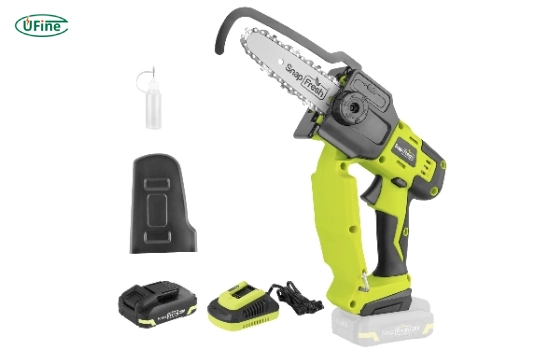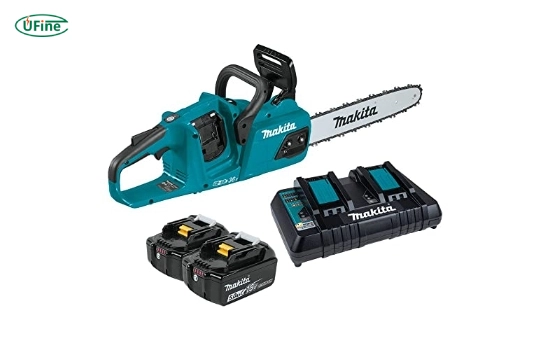A chainsaw battery is crucial for anyone looking to operate a chainsaw efficiently and effectively. As the demand for electric chainsaws rises, understanding the various aspects of chainsaw batteries becomes essential. This guide will explore everything you need about chainsaw batteries, including their types, benefits, maintenance tips, and more.
Part 1. What is a chainsaw battery?
A chainsaw battery is a rechargeable power source designed specifically for electric chainsaws. Unlike gas-powered chainsaws, which rely on fuel combustion, battery-operated chainsaws use lithium-ion batteries to deliver power. These batteries are lightweight, efficient, and environmentally friendly, making them an excellent choice for many users.
Part 2. Types of chainsaw batteries
When it comes to chainsaw batteries, there are primarily two types:
- Lithium-ion Batteries: These batteries are the most common type used in modern electric chainsaws. They provide high energy density, meaning they can store much power in a relatively small size. Lithium-ion batteries also have a longer lifespan and charge faster than other types.
- Nickel-Cadmium (NiCd) Batteries: While less common today, NiCd batteries were once the standard for many power tools. They are heavier and have a lower energy density compared to lithium-ion batteries. However, they can perform well in extreme temperatures and have a longer cycle life.
Part 3. Benefits of using a battery-powered chainsaw
Using a battery-powered chainsaw comes with several advantages:
- Portability: Without gas or cords, battery-operated chainsaws are easily transported and used in remote locations.
- Quiet Operation: Electric chainsaws tend to be more peaceful than their gas counterparts, making them suitable for residential areas where noise restrictions may apply.
- Low Maintenance: Battery-powered models require less maintenance than gas-powered chainsaws since there are no fuel filters or spark plugs to worry about.
- Environmentally Friendly: These chainsaws produce no emissions during operation, making them a greener choice for cutting wood.
Part 4. How long do chainsaw batteries last?
The lifespan of a chainsaw battery depends on several factors:
- Battery Capacity: Measured in amp-hours (Ah), higher capacity batteries can provide longer run times.
- Usage Conditions: Heavy usage will drain the battery faster than light tasks.
- Age of the Battery: Over time, all rechargeable batteries lose their ability to hold a charge effectively.
Typically, a lithium-ion battery lasts anywhere from 30 minutes to several hours on a full charge, depending on the abovementioned factors.
Part 5. How many volts is a lithium battery chainsaw?
The voltage of lithium battery chainsaws can vary significantly based on the model and manufacturer. Common voltages include:
- 12 Volts: Ideal for light-duty tasks, like pruning or trimming small branches.
- 18 Volts: Suitable for light-duty tasks and smaller cutting jobs.
- 40 Volts: Provides more power for medium-duty tasks and larger cutting jobs.
- 80 Volts or Higher: These batteries, designed for heavy-duty use, offer maximum power and efficiency for professional applications.
Choosing the proper voltage depends on your needs and the work you plan to do with your chainsaw.
Part 6. How to choose the right chainsaw battery?
Choosing the right chainsaw battery involves considering several key factors:
- Compatibility: Not all batteries are universal, so double-check that the battery works with your specific chainsaw model. Many brands provide interchangeable batteries for other tools, which is a plus if you’ve already chosen a particular brand’s ecosystem. Always verify voltage and connector types for a seamless fit.
- Capacity (Amp-Hour Rating – Ah): Battery capacity, measured in amp-hours (Ah), affects how long you can run the chainsaw before recharging. A higher Ah rating is ideal for extended cutting jobs. For light pruning or quick tasks, a 2.0Ah battery may suffice, while heavy-duty users should consider 4.0Ah or higher. Larger capacities, though heavier, reduce the need for frequent recharges.
- Voltage: Voltage affects both power and runtime. While higher voltage (e.g., 40V to 80V) provides more control for cutting dense or thicker wood, it also adds weight to the chainsaw. A 12V or 18V battery may be enough for light trimming, but if you’re dealing with harder or larger wood, 40V or more will offer better efficiency. Consider what kind of cutting you’ll do most often to strike the right balance between power and weight.
- Charging Speed and Cycle Life: Fast-charging batteries can minimize downtime but often cost more. Batteries with higher cycle life (number of charges before capacity depletes) may be a better long-term investment. Check for technologies like “smart charging” or thermal management systems, which prevent overheating and extend battery life.
- Weather and Temperature Resistance: Some lithium-ion batteries perform poorly in extreme cold or hot conditions. If you plan to use your chainsaw in varying climates, look for batteries rated for weather resistance or built-in protection against temperature fluctuations.
- Brand and Warranty: Stick to reputable brands known for their durability and customer service. A good warranty (typically two to five years) offers peace of mind. Some brands offer extended warranties or replacements, which is especially important if you rely on your chainsaw for frequent or professional use.
Part 7. Charging your chainsaw battery
Proper charging practices can extend the life of your chainsaw battery:
- Use the Correct Charger: Always use the charger that comes with your chainsaw or one recommended by the manufacturer.
- Avoid Overcharging: Most modern chargers have built-in safety features to prevent overcharging, but it’s still wise to unplug once fully charged.
- Charge at Room Temperature: Extreme temperatures can affect charging efficiency and battery health.
Part 8. Maintaining your chainsaw battery
To keep your chainsaw battery in optimal condition:
- Store Properly: Keep the battery in a cool, dry place when not in use. Avoid exposing it to extreme temperatures.
- Regular Use: If you use your chainsaw sparingly, charge the battery every few months to prevent it from losing capacity.
- Inspect Regularly: Check for any wear or damage on the battery casing or terminals.
Part 9. Troubleshooting common issues with chainsaw batteries
Sometimes, you may encounter issues with your chainsaw battery. Here are some common problems and solutions:
- Battery Not Charging? Check if the charger functions correctly and ensure connections are clean and secure.
- Short Run Time? If your battery drains quickly, it may be time for a replacement or to check whether you’re continuously using it under heavy load.
- Overheating? Allow the battery to cool down before recharging. If overheating persists, consult the manufacturer for further guidance.
Part 10. FAQs
-
What is the average lifespan of a lithium-ion chainsaw battery?
With proper care and maintenance, the average lifespan of a lithium-ion chainsaw battery is 2–5 years. -
Can I use my gas-powered charger to charge my electric chainsaw?
No, using a gas-powered charger can damage your electric chainsaw’s battery. Always use the designated charger provided by the manufacturer. -
How do I know when my chainsaw battery needs replacing?
Signs that your battery may need replacing include significantly reduced runtime between charges or physical damage such as swelling or cracks in the casing. -
What should I do if my chainsaw won’t start after charging?
If your chainsaw won’t start after charging, ensure it’s properly connected and no debris obstructs any moving parts. If problems persist, consult customer support or refer to your user manual. -
How can I extend my lithium-ion battery’s lifespan?
To extend your lithium-ion battery’s lifespan, avoid complete discharges frequently, store it at moderate temperatures, and charge it regularly without letting it sit unused for extended periods.
Related Tags:
More Articles

10440 Battery Guide: Size, Voltage, Capacity, Uses & More
Understand 10440 batteries better—size, voltage, safety, and how they compare to AAA. Find the best fit for your high-performance devices.
White Stuff on Battery Terminals: A Step-by-Step Cleaning and Maintenance Guide
White stuff on battery terminals is corrosion. Learn how to clean it safely, prevent damage, and keep your battery running strong with simple steps.
Understanding How Glass Mat Batteries Work: Technology, Benefits, and Limitations
Glass mat batteries power cars, RVs, and solar systems. Learn how they work, their benefits, and what to consider before choosing one.
A Buyer’s Guide for AA Size Lithium Battery
Discover the power of AA size lithium batteries—types, voltage, capacity, and more! Learn how to choose the best one for your needs. Read now!
Li-Ion Battery Prices – Where to Buy Cheap & Safe
Discover li-ion cell prices, key market factors, and how to find affordable custom batteries from top suppliers like Ufine Battery.





